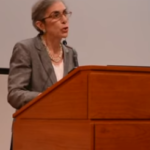Déjà Vu All Over Again at Harvard

On January 24th, the Supreme Court agreed to hear a case, Fair Admissions v. Harvard University, which not only has some profound implications for the future of affirmative action in college admissions, but also raises again a troublesome and ignoble part of Harvard’s history with Jewish applicants early in the 20th century.
At issue in the case is the accusation that Harvard discriminates against Asian Americans in its admission process, that were Asian students judged on academic achievement and test scores alone, they would be admitted in far greater numbers than they currently are. Rather than using the metrics long-used by admissions officers to admit qualified students, Harvard (as well as many other universities) uses what is described as a “holistic” approach to evaluating a candidate, creating a “personal rating” of an applicant that includes non-academic factors, using that as either a positive or a negative depending on the applicant.
So, a black applicant from a low socio-economic background will receive positive “tips” toward admission, for instance, while an Asian student’s purported lack of such qualities, outlined in a case brief, as “integrity, helpfulness, courage, kindness, fortitude, empathy, self-confidence, leadership ability, maturity, and grit,” will result in a negative “tip” when evaluating that student’s admissions package.
That discriminatory practice is eerily familiar to the same perverse formula used by Harvard in the early 20th century during the presidency of the anti-Semitic A. Lawrence Lowell, who was alarmed at the increasing number of Jews on the Harvard campus as a result of their academic excellence. In fact, a 2021 brief filed in the case by The Louis D. Brandeis Center for Human Rights Under Law and The Silicon Valley Chinese Association Foundation noted that very point, commenting that “Just as Harvard used methods in the 1920s and 1930s to identify applicants of sufficient ‘character and fitness’ as a pretext to discriminate against Jews, Harvard’s current use of the ‘personal rating’ to pursue student-body diversity is a pretext to discriminate against Asian Americans.”
But while a similarity exists between Harvard’s unlawful and immoral filtering of “undesirable” Jewish applicants and its current treatment of Asian applicants, the motivation for instituting the discriminatory process was significantly different. Asian applicants are disfavored in the admission process primarily because, on race-obsessed campuses where admissions officers relentless pursue minority applicants to achieve racial balance and “equity,” academic standards for minority students have had to be lowered and “holistic” aspects added to make them competitive with high-achieving Asian applicants, applicants who, curiously, are not considered to be part of a minority group.
When Harvard was fixated on its “Jewish problem,” however, the desire to exclude Jews from matriculating had an even more pernicious aspect to it. Yes, Jews were academically over-achieving compared to their Gentile peers so that, based on grades alone, at least, Jewish applicants were a threat to the children of the Protestant elite, just as Asians are now a threat to minority applicants with lower scores and grades.
Harvard’s darker and more compelling motivation for restricting the number of Jews, however, was, as then-President Lowell wrote to a Harvard professor, his belief that “the presence of Jews in large numbers tends to drive gentiles elsewhere” and that “a few years ago many of us thought the proportion of Jews in Harvard college was reaching a dangerous point.” As meticulously chronicled in Jerome Karabel’s seminal book about bigotry in the Ivy League, The Chosen: The Hidden History of Admission and Exclusion at Harvard, Yale, and Princeton, Harvard’s “reputation of having so many Jews,” it was assumed, was hurting its ability to “attract applicants from western cities and the great preparatory schools.”
Lowell’s belief that ‘a very large proportion of the less desirable . . . are at the present time the Jews” was apparently shared with Harvard alums, as well. Karabel recounts, for example, how “[Harvard alum Jerome D.] Green wrote to Lowell, expressing his view that the ‘Jewish problem’ resided less in any deficiencies among Harvard’s Jewish students than in the response of their non Jewish classmates to their very presence on campus . . ,” and supported an admissions process that “would undoubtedly . . . reduce materially the number of those Jews who are of objectionable personality and manners.”
The case materials also include a letter from another Harvard alum, W.F. Williams ’01 to President Lowell, “castigating the school for being overrun by Jewish students.” And Williams did not even attempt to masque his obvious anti-Semitism, writing to Lowell that, “Naturally, after twenty-five years, one expects to find many changes but to find that one’s University had become so Hebrewized [sic] was a fearful shock. There were Jews to the right of me, Jews to the left of me, in fact they were so obviously everywhere that instead of leaving the Yard with pleasant memories of the past I left with a feeling of utter disgust of the present and grave doubts about the future of my Alma Mater . . . .”
Williams further urged Lowell to concoct a system for filtering out Jews so that Harvard could remain a school for the Gentile elite, free of a “Jewish problem.” “Are the Overseers so lacking in genius,” he asked Lowell, revealing a trace of the racial anti-Semitism popular at the time, “that they can’t devise a way to bring Harvard back to the position it always held as a ‘white man’s’ college?”
So while Harvard seems to deny Asians entrance now because they would occupy slots saved for minority applicants to help achieve diversity and inclusion, the purpose of excluding Jews was to actually cleanse the campus of an undesirable race, a group that had caused Lowell, for one, to have “had foreseen the peril of having too large of a number of an alien race and had tried to prevent it.” In today’s parlance, Jews would diminish the brand image of Harvard, and the University’s key target group—the white Gentile children of America’s elite—might be driven away by the perception that Harvard was too Jewish.
As a result, the “holistic” admissions process was devised and “The centerpiece of the new policy would be ‘character,’” Karabel noted, “a quality thought to be in short supply among Jews but present in abundance among high-status Protestants.”
It seems clear that Harvard discriminates against Asian applicants, not because it believes them to be undesirable in the same way it thought Jews to be—and therefore set up quotas for each group—but because they have been forced to reduce the raw number of qualified Asian applicants to accommodate slots that they wish to fill with black and other minority students, under-represented students with significantly lower academic achievement than their Asian peers.
In fact, in response to the lawsuit, Harvard did not even try to disguise the fact that minority applicants benefit from different, lower admissions criteria, and, as the court documents revealed, “Harvard concedes that admission officers can and do often intentionally discriminate based on race by granting ‘tips’ to favor African Americans and Hispanics in the overall rating . . . [and that] Harvard ‘intends’ that race be factored in this rating.”
It is very unlikely that white students are considering not applying to Harvard because they perceive the University to have a high proportion of Asian students, nor is there evidence that white students, or even black or Hispanic students, would ever turn down an admission offer to Yale, Princeton, Stanford, MIT, Chicago, or other elite institutions because of the presence of a high proportion of Asian students.
It is possible, of course, that some students, especially those currently benefiting from affirmative action admissions and a campaign to recruit a more diverse student body at the top universities, could harbor resentment at how well Asians have demonstrated they can excel academically. But the notion that students would avoid schools precisely because of an over-representation of Asians—as it was feared that upper-crust Gentiles would do precisely because of an over-representation of Jews—is improbable at best.
That does not lessen the offensive nature of the discriminatory admissions process which unfairly filters out deserving Asian students, but it does indicate that there is a distinction in both the motives and morality of how Jews had been excluded from Harvard in the 1920s and 30s; namely, the administration believed and acted on the assumption that, like themselves, potential Gentile applicants basically loathed Jews and did not want to attend a university at which they had a noticeable and, it was thought, deleterious and debasing effect on the campus community.
In a brief filed in a similar 2013 case addressing discrimination in admissions, Fisher v. University of Texas at Austin, the “holistic approach” used to assess an applicant’s fitness for admission was again critiqued, precisely because it “shrouds admissions decisions in a veil of secrecy. Indeed, it was originally created specifically to hide discrimination against Jews and to allow the colleges to admit or reject anyone they wanted and for any reason. Even today, it is used to hide not only illegal racial balancing but also out and-out corruption . . . [and] gives the universities a license to cheat (which, as history has demonstrated, they have a propensity to do).”
When the process was used a century ago by Harvard admissions officers and others to deny Jews the chance to matriculate, it was wrong; and it is wrong again when the spirit and intent of the admissions process are compromised by denying Asians the educational prizes they justifiably deserve.




